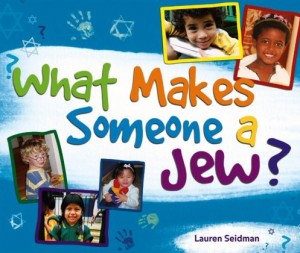Enlightenment
Jewish Yemenite Kiddush
Traditional Jewish Yemenite music comprised of prayers, stories and chants sung together with drums or clapping. It is sung before the ceremony of havdalah, religious ceremony that marks the symbolic end of Shabbat or holidays, and ushers in the new week.
An inspiring Rosh Hashanah Sermon from Congregation Beth-El Zedeck!
But You Don’t Look Jewish by Rabbi Sandy Eisenberg Sasso
Read it HERE!
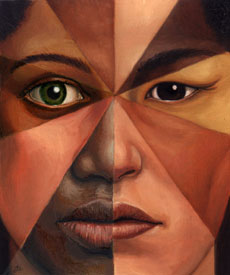
Jews come in every shape, size, and color. With this delightful new book from Debra Darvick, children will learn that no matter what they look like or where they are from, they are part of the Jewish family. Featuring full-color photographs showing the diversity of the Jewish community, this book is ideal for families, early childhood centers, and outreach programs.
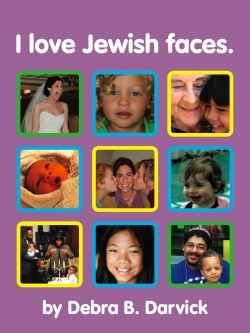 By Award-winning author Debra Darvick
By Award-winning author Debra Darvick
See inside!
Shlomo Mula grew up in the Jewish village of Macha, northern Ethiopa. In September 2008 he became the second Ethiopian ever elected to the Israeli Knesset.
![]()
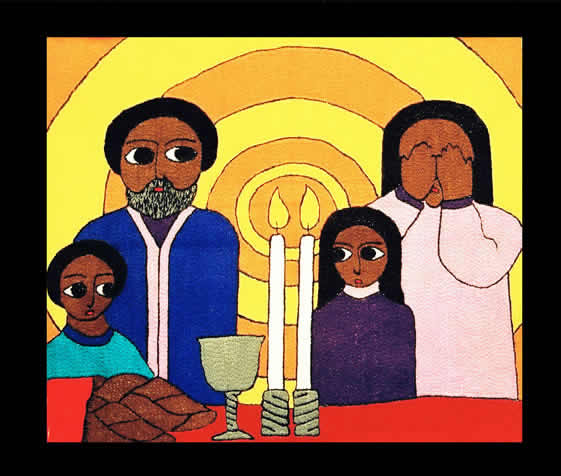 Support the NACOEJ Embroidery Project
Support the NACOEJ Embroidery Project
Chag Sameach!
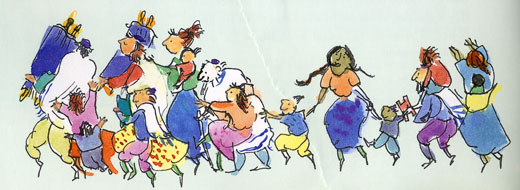 From the book Jewish Holidays All Year Round by Ilene Cooper and illustrated by Elivia Savadier
From the book Jewish Holidays All Year Round by Ilene Cooper and illustrated by Elivia Savadier
Simchat Torah FAQ
Everything you ever wanted to know about the holiday
Be’chol Lashon Podcast Interview
Rahel Musleah talks with Be’chol Lashon’s Francesca Biller-Safran about her Baghdadi Jewish family, their Rosh Hashanah traditions, and her book “Apples and Pomegranates.”
What Makes Someone a Jew? by Lauren Seidman, Published by Jewish Lights
“Finally! A beautiful book that celebrates the diversity of Jews, of all colors, from all families, and from all places. Offers thoughtful answers to the questions often asked by adopted Jews, Jews of color, and even Jews from traditional families about what it means to be Jewish. Affirms young Jewish identity with great heart. It belongs in every Jewish home!” ~Rabbi/Cantor Angela Warnick Buchdahl, Central Synagogue, New York
“A delightful corrective and addition to the field of Jewish children’s books. Recognizes the beauty and diversity of Jewish life and people. I recommend it for all Jewish families.”
~Yosef Israel Abramowitz, founder, Jewish Family & Life!; coauthor, Holidays and Values for Today’s Parents and Children
In Loving Color
By Rachel Sarah
Raising a biracial Jewish daughter, a mother finds herself answering many questions: from her child, from total strangers, and from her own heart.
“Mommy, you became Jewish when you had me.”
That’s how Mae, my eight-year-old daughter, explains it, and she’s right. Sort of. Mae was seven months old when her father walked out and I became a single mom. At that point in my life, I’d never been so far from Judaism. I was firmly planted in motherhood, but it would take me a while to see that I needed my religious roots to unfold.
Today, Mae is a spirited second grader with a beautiful afro, cinnamon skin, and full lips. Many people assume we’re not related. But Mae — who is quite a sensitive child otherwise—isn’t self-conscious about looking different from her Jewish peers. I, her mother, am the one who sometimes feels — or is made to feel — insecure.
It’s not as if we shouldn’t be used to the idea of mixed-race heritage. There are Jews everywhere — Ethiopia, Russia, China, India. Everyone who visits Israel tells a story of meeting someone who, because of skin color or another physical characteristic, she simply couldn’t believe is one of us. In the United States, according to one study, one of every five Jews (1.2 million people!) is either black, Asian, Latino, of mixed race, or of Sephardic background.
Not me. I’m white, of mostly Polish descent. My father is Jewish; my mother was born Catholic. She stopped going to church in her 20s and supported the raising of her children as Jewish (although she didn’t convert). I had a bat mitzvah and a confirmation. I went to Jewish summer camps. I went to Israel. I was told that 60 of my relatives were lost in the Holocaust — the single fact that always kept me deeply connected to Judaism. But when, in my 17th year, a rabbi in Israel told me that I wasn’t “really” Jewish because my heritage hadn’t been passed down matrilineally, I was crushed. In anger and disappointment, I distanced myself from anything Jewish for more than a decade.
Twelve years later I had Mae. I was living in New York City, and, despite its large Jewish population, I didn’t know any who were of mixed race. When I moved back to the Bay Area to be near my family, there was a Jewish preschool down the street, but I was adamant about not sending Mae there: If I’d felt shunned for not having a Jewish mother, imagine how she would feel. So, I found a diverse, high-energy preschool; she cried for a week. Every afternoon when I picked her up, her eyes were bloodshot.
Friends raved about the nearby Jewish pre-school, so I called: A spot had just opened up. I was unsure, but the moment Mae walked into Kitah Aleph, she felt at home. And she was not alone. Three children were Jewish Asian, one boy was African-American, and a Spanish-speaking girl — her mother, from Venezuela, had worked at the JCC for more than a decade — is still one of Mae’s best friends.
Mae never wanted to go home when school let out. She learned how to count in Hebrew and how to braid (practicing on challah). She expanded my repertoire of Jewish songs tenfold.
But it wasn’t perfect. I once took 5-year-old Mae to a local kids’ Shabbat service at a Conservative shul. We walked in, and everyone stared. After the service, only one person came up and said, “Hi.” She was the white mom of an adopted son with brown skin. While researching this article, I called that mom —who asked to remain anonymous — and asked whether anyone at her temple mentioned her son’s race. “They ignore it,” she said. “No one talks about it.”
Nevertheless, her son recently said to her, “Mommy, most Jews are white.”
Lisa Williamson Rosenberg, a New Jersey psychotherapist and writer, is both Jewish and biracial (her mother is white and Jewish; her father was black). Fortunately, she reports, “the definition of what a Jew looks like has broadened significantly since I was a kid.” She remembers being told, “How can you be Jewish? You’re black.” “As if the two were mutually exclusive,” adds the mother of two (her husband is white and Jewish).
“Today when I say, ‘I’m Jewish,’ I may get a respectful question or two,” Rosenberg says, “but I won’t get the same kind of disbelief I might have in the ’60s. On our two coasts, if you walk into a synagogue there’s a good chance you will find at least a few brownish faces. I think it’s due to the high numbers of interracial marriages, conversions, and transracial adoptions by Jewish parents.”
Diane Kaufmann Tobin, associate director of the Institute for Jewish and Community Research in San Francisco, agrees.
“When I adopted Jonah, I didn’t know any black Jews,” Tobin says about her 10-year-old son, whom she adopted with her husband, Gary, the institute’s president. “I wanted him to grow up Jewish and not have to choose between his racial and religious identities.”
The Tobins, both of whom are white, were determined to find a place where Jonah would feel “very at home being both Jewish and black.” So, they founded San Francisco’s Be’chol Lashon (In Every Tongue) program, which “grows and strengthens the Jewish people through ethnic, cultural, and racial inclusiveness.”
Clearly I’m not the only white mother who hopes her child will feel pride in every facet of her identity. Right now, Mae considers herself Jewish, while others define her — on the basis of what they can see — as black. Looking ahead, I’m not ready for the changes sure to come in her teenage years and beyond, both with how Mae sees herself and how the world does.
I ask Rosenberg for advice on raising my child. “It’s important not to let the black part get lost,” she says.” Being black is something many biracial people take a long time to come to terms with — I did — especially if they identify strongly with whatever makes up the other half. But I believe it’s important to teach a biracial child to love the black in herself, along with everything else.”
One of my closest friends — a white, Jewish mom whose extended family is Orthodox — is doing just that. She had her 7-year-old daughter with an African man who’s no longer in the picture. The Jewish part is easy, says my friend (who requests to keep her family anonymous) about raising her daughter. “She was named in a Jewish ceremony at temple. My grandmother even came out from the Midwest.” And her daughter? “She never questions that she is Jewish.”
Instead, my friend worries about helping her child identify with the rest of her background. During Black History Month, her daughter started asking questions about her African roots. Not sure what to do, my friend enrolled her first-grader in an African drumming class; she didn’t love it, but Mom persuaded her to keep going “because I don’t know how to help her feel the parts of her that are not parts of me.”
“It’s hard, with so many negative images of blacks in the media, especially if the child isn’t living with a black family member,” Rosenberg adds. “It’s a process that I’m still working on. And I’m in my 40s.”
My daughter, too, seems to have no questions about her Jewishness. She is secure and happy at our local JCC. She attends a Jewish after-school program and will soon start her fourth summer at Jewish day camp. When she’s with her Jewish friends, she isn’t shy, the way she often is in public. She volunteers to act in skits; she shows new kids where the bathroom is; she teases her counselors . (She did confess to embarrassment, however, when she was recently proclaimed “Mensch of the Week” in front of the entire after-school group).
I’m the one still feeling like an outsider.
Recently, a Jewish friend invited us to a neighborhood party. As I was pouring myself a glass of wine—and Mae was asking if she could have another cookie — a local dad asked me, “Where did you adopt your daughter?”
Pointing to my belly I answered point-blank, “She came from right here.”
I’ve got that answer down pat because adults and children have asked me many times whether Mae was adopted (along with other common kid questions, like “Why is her hair curly and yours straight?” and “Where’s her daddy?”).
Scott Rubin, a Jewish dad in San Francisco who, with his partner Stephen Moore, has adopted two children, one African-American, the other African-American and Latino, says that strangers also have approached him with questions. First, he tries to gauge their intentions. Then, he wants to know why they’re asking. “I always try to tell the truth,” he says, “but I don’t always elaborate. And if they ask, ‘Are they your kids?’ I say, ‘Yes.’ But I do not engage in conversations about ethnicity or race with strangers. Ever.”
Says Diane Tobin, “What I’ve learned from other Jews of color is they don’t want to be asked, ‘Why are you Jewish?’ or ‘How are you Jewish?’ It’s rude. We need to educate people about what to say or not to say.”
For me, biracial Judaism is a touchy subject. When white Jews ask about my daughter’s identity, I appreciate their curiosity as long as their tone is respectful and warm and as long as their questions are directed to me.
Rosenberg says, “It’s not your daughter’s job to answer. As a parent, you need to step in and say, ‘Why do you ask?'”
Still, if Jews are not acknowledging my daughter’s biracial identity, are they really ignoring her?
“Don’t look at the container, but look at what’s inside.” That’s from Pirkei Avot — Ethics of Our Fathers, Chapter 4, Mishnah 27. I’m led to that tenet by Rabbi Judah Dardik of the Beth Jacob Congregation in Oakland. Although we couldn’t be more mismatched — I’m a 35-year-old single mom who never goes to temple and had a child with a man outside the tribe; he’s Orthodox, married, and the father of four — Dardik is my go-to rabbi because he’s thoughtful, respectful, and patient.
I catch him on the phone on a Friday, an hour before sundown, and apologize for not calling earlier. I tell him that I’m trying to write about what it’s like to raise a biracial Jewish child, but every time I sit down at my computer, what comes out sounds overly defensive.
“Many Ashkenazi Jews tend to assume that Jews are white,” Dardik says, “but it’s not true. Jews come in different shades and colors.” In Judaism, he explains, what matters is not what you look like on the outside — your “container” — but what “merit you have on the inside.”
I’ve done something right, because clearly Mae isn’t afraid to show her “inside.” Maybe it’s time for me to open up a little bit, too.
 Cover by Art Spiegelman
Cover by Art Spiegelman
Two Jews in Love. Can you handle it? Come to terms with your own inner truths.
Excerpt from: ‘Funny He Doesn’t Look Jewish’ by Joshua Hammerman, The Jewish Week
“…The great Baha’i prophet, the Baha’ullah (1817-1892), called racism the greatest challenge to global unity. Jews should be champions of this ideal. Long before the Baha’ullah walked this earth, Jews were the world’s greatest conduit of multiculturalism. While Christians and Muslims spent most of the Middle Ages constantly building fences and re-drawing borders, Jews were constantly traversing them, carrying the best that every culture could offer.
Baha’i followers view interracial marriage as the ideal relationship. Until all too recently, many Jews considered such matches a shandeh (disgrace), even when both spouses were Jewish. Part of that is attributable to a legitimate concern that children of such marriages would be subjected to ridicule on the playground. But part of it is outright racism.”
Seasons in Sheol: A Black Woman’s Nightmare Journey
Through Synagogue Culture
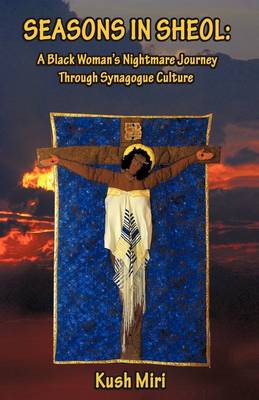
A self-professed and eager integrationist, author Kush Miri converted to Judaism and entered the synagogue’s employ with high hopes and an open heart. Her experiences there left her without faith in God, physically and mentally scarred, and abandoned by her congregation. In this memoir, Miri reveals the discrimination and persecution that took place during her seven years of employment.
Season in Sheol paints a portrait of Miri’s difficult inner-city childhood, her early family and religious experiences, and her journey to enter the Jewish faith. Ten years after converting to Judaism, Miri accepts a job in a synagogue and immerses herself in Jewish culture. Her descriptions of the activities, rites and practices of Judaism, and Judaism’s history provide a fresh and comprehensive overview for both Jews and non-Jews. Initially welcomed among her congregation, Miri experienced a radical change in their attitude. With the arrival of a new rabbi, she found herself castigated by congregants with whom she had formed warm and cordial relations.
Despite her bitter experience, Miri refuses to renounce Judaism—an essential part of her identity. Season in Sheol serves as an important reminder that people can convince themselves of inner good while committing outer acts of malice.
Kushi Miri was a teen actress in musical theatre. As a writer, her journalism has appeared in national magazines, and her poetry has appeared in literary anthologies. She is an accomplished textile artist and her artwork has been on exhibit throughout the Northeast. She is married and has one daughter. I am honored to call her my friend.
